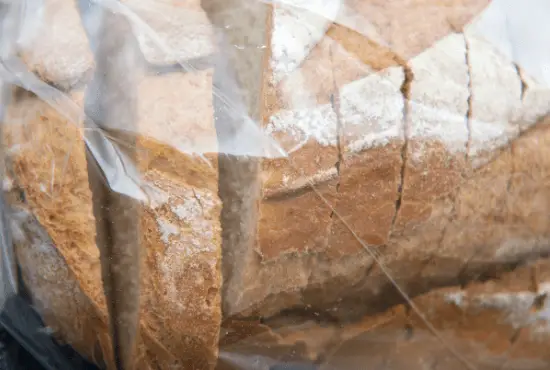Homemade or store-bought, white or brown, bread is consumed by almost everyone. Most people who don’t use bread often prefer freezing it to store the remaining bread for a long time. In case you thawed a whole loaf and ended up using just a slice or two, you might be wondering can you refreeze bread?
Homemade and store-bought bread are safe to refreeze. Properly refrozen store-bought bread will last you six months in the freezer, whereas homemade bread will last for up to 3 months. Ingredients used in bread also affect how well it refreezes. Refreezing in portions and carefully wrapping the bread will help the bread retain optimum flavor and quality. However, refreezing bread more than twice is not recommended.
While refreezing bread is a great way to store it for a long time, carefully following the refreezing instructions is the best way to avoid sour bread.
Table of Contents
Is it Safe to Refreeze bread?
By following the refreezing instructions carefully and remembering a few important things, you can successfully refreeze homemade and store-bought bread.
Bread is safe to refreeze if you pop it back into the freezer within 48 hours of thawing. If you let it sit at room temperature for any longer than recommended. In that case, its chances of getting contaminated are very high.
Although store-bought and homemade bread refreeze equally well, the lasting period varies. It is because store-bought bread contains preservatives that increase its shelf life.
Note: You can safely refreeze white, as well as brown or whole-wheat bread. Also, as long as all the ingredients used are freezer-friendly, you are good to go with the refreezing steps. Ingredients like eggs act as good enhancers for the refreezing process. Whether the bread is yeast-free and gluten-free or not, also impacts how well it refreezes.
Types of Bread and How They Tolerate Refreezing
The type of bread you want to refreeze also determines how well the bread will refreeze. Some bread refreeze very well, while others are better when consumed fresh.
Some common types of bread and their refreezing abilities are discussed as follows:
1. Egg bread

Bread that involves the use of eggs for preparation is called egg bread such as Challah and Brioche.
Egg bread freeze and refreeze well because the eggs help keep the texture of bread soft and crumble-free. Bread made with eggs stays fresh for a longer time than those made without eggs. Eggs may also improve the rising power of bread.
2. Sourdough bread

Sourdough bread is considered more flavorful and it is made with special yeast.
The difference between traditional and sourdough bread is that the yeast used to prepare sourdough isn’t commercially. Instead, it uses a sourdough starter – fermented flour and water mixture that contain wild yeast – for its preparation.
Sourdough bread tastes best when used fresh. You can store properly wrapped sourdough bread in a refrigerator for up to 4-5 days.
Sourdough bread doesn’t last well in the freezer. The crunch and the taste of sourdough bread quickly start degrading.
3. Gluten-free bread

Gluten-free bread is ideal for people who have gluten allergies—all the ingredients used in the preparation of gluten-free bread aids in refreezing process exceptionally well.
You can keep carefully refrozen gluten-free bread in the freezer for as long as three months; however, you must use it within the recommended time. Because once the 3-month limit is crossed, it is not advised to use the bread.
4. Quick bread

Any bread made using a leavening agent (such as baking powder or baking soda) which allows immediate baking of the dough mixture is called quick bread.
Quick bread doesn’t need time to rise and you can prepare it quickly. For instance, Cornbread and Soda bread are two common examples of quick bread.
Most types of quick bread refreeze well. You can safely refreeze quick bread for 2-3 months with proper handling.
How Can You Refreeze Bread?

Things to consider for safe refreezing of bread are as follows:
- In the case of store-bought bread, you can go ahead and place the packaged bread inside the freezer. Just make sure the package isn’t ruptured and there’s no extra moisture present inside.
- First, to refreeze homemade bread, cut the loaf into slices and divide them into portions as required. It will not only help you take out the needed slices easily, but it will also save the rest of the bread from thawing.
- Transfer the slices into an airtight container or freezer-safe bag.
- Make sure you label the date of refreezing on the bag or container. Doing so will help you track how long you can store the bread.
- Lastly, pop the labeled container or bag into the freezer.
Store-bought bread comes with a best before date and you can refreeze the bread before the best before date has passed. Otherwise, you might end up with sour bread.
How Long Can You Refreeze Bread?
Store-bought bread can be kept refrozen for as long as six months. Make sure that you refreeze store-bought bread before the best before date on the packaging has passed.
On the other hand, Homemade bread lasts for a shorter time in the freezer. You can keep homemade bread refrozen for up to 3 months. Homemade bread has a shorter life than store-bought one because no preservatives are used in the preparation.
Can You Refreeze Bread More Than Once?
You can refreeze bread two times after freezing. However, refreezing the bread for the third time isn’t recommended.
When you thaw the bread for the third time, it might start crumbling into pieces. After being refrozen twice, the bread may start tasting stale. The quality and texture rapidly deteriorate after being thawed three times.
If you want to use frozen bread and enjoy rich texture and high quality, you can refreeze bread in portions. Refreezing bread in portions helps you only take out the required slices and save unused bread’s quality from further degradation.
How to Know if The Frozen Bread Has Gone Bad?
You can quickly tell if the bread has gone bad or not by carefully observing the bread. If you notice any of the following signs, you should toss away the bread.
- Check if there are any molds on the bread. Bread that has gone bad will have green, black or white molds on the surface of the bread.
- If the bread has gone bad, it will have a rotten smell.
- Notice the texture of the bread. If the bread has a hard texture even after being appropriately thawed, it means the bread has spoiled.
- If you cannot notice any of these, but the taste seems sour or unpleasant, you should immediately discard the bread.
Store-bought bread is safe for use even after the best-before or best-by dates, as long as you don’t notice any of the signs mentioned above.
Conclusion
If you follow the refreezing instructions carefully, you can safely keep the bread refrozen for as long as 3-6-months. The refreezing abilities of bread greatly depend upon the type of bread and ingredients used.
You can consume the bread even after the recommended time limit has crossed if you don’t notice any signs of expiration. However, if the time limit hasn’t passed, but you still see signs of decay, it’s not recommended to use the bread.


